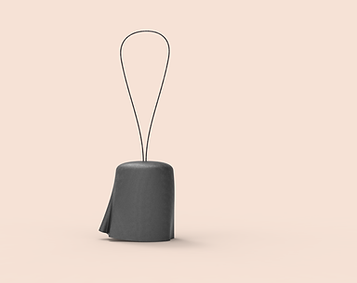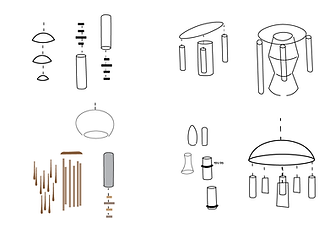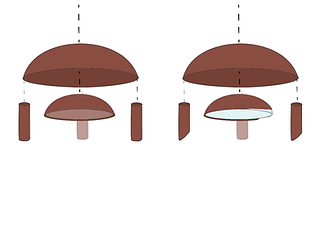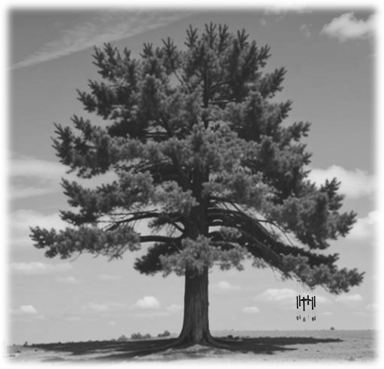Gone with the Wind
In short This project presents a redesigned Jewish ash urn as a response to a design competition by Aleh Shalechet, an alternative burial service in Israel. The design won third place in the competition. The urn redefines the way ashes are scattered by integrating natural elements and gradual dispersion, creating a meaningful farewell process.
Need For some secular Jews, cremation aligns with ecological values and the Jewish principle of returning to the earth. However, the rapid and abrupt scattering process does not always align with the emotional and spiritual needs of mourners. Families seek a ritual that reflects both Jewish heritage and sustainability, while allowing a gradual, respectful, and personal farewell.
Concept Designing an ash scattering practice that gives voice, form, and rhythm to the scattering process, echoing the processes of mourning and separation and accompanying the natural ritual of a body's return to its soil.
Background Thousands of people in Israel choose cremation as their burial method each year. The main reasons for preferring this method are ecological concerns and a desire to avoid a religious funeral ceremony.
The burial ceremony in Israel usually begins with the receipt of the cremated remains, and their scattering in nature a few days later in a civil ceremony in an intimate forum.
The cremated remains weigh about three kilos of coarse sand-like material made of bone fragments, minerals, and salts.



These days, choosing the ash process expresses acceptance of the body's process of elimination: the material passes away and returns to its natural place without the need for a tombstone. This completes a conceptual circle of a full return to the earth.
The goal of the project is to search for an object that accompanies the transition from the cremation site to the scattering ceremony. This object should encode non-religious cultural values alongside ecological concepts that echo the perception of the living body as a transient element in the world.


These days, choosing the ash process expresses acceptance of the body's process of elimination: the material passes away and returns to its natural place without the need for a tombstone. This completes a conceptual circle of a full return to the earth.
The goal of the project is to search for an object that accompanies the transition from the cremation site to the scattering ceremony. This object should encode non-religious cultural values alongside ecological concepts that echo the perception of the living body as a transient element in the world.
During the ceremony, the urn is placed in nature and acts as an independent dispersing bell, remaining in nature for a slow dispersal process. The deceased's relatives return to collect the urn after completing a mourning cycle.
In this process, the return to the earth occurs naturally and the deceased's relatives are only required to place the dispersal object in a place that allows for a gradual and respectful dispersal process. From there, all that remains is to let nature take its course.
timeline
Day of Death
Receipt of the body, cremation
Day of Scattering
Putting the Ashes into the Scattering Tank
Transporting and Erecting the Scattering Structure
Farewell Ceremony and Beginning of the Scattering Process
Completing the mourning cycle
Scattering the remains of the ashes
folding the scattering platform returning it to use
/ leaving the object as a permanent monument
(optional) Ceremony of ascending to the scattering site
CMF The design of the object is characterized by a smooth, clean and simple aesthetic that focuses the viewer on the idea of gradual dispersion.
The structure of the bell creates a circular shape, which corresponds with the cultural image of the circle of life.
The bell is characterized by natural materials: warm metals and lively wooden sails without additional painting that allow for an unpretentious resonance.

Cultural Values
The idea of coming out of dust and returning to dust appears already in the Book of Genesis. God states to Adam - 'From dust you came and to dust you will return' after eating from the tree of knowledge.
The Hebrew word for wind, רוח, is used to describe the movement of air but also the presence of an inner force, a spirit. This duality of meaning adds another layer to the object that scatters the remains of the body's representation in the world.
In ancient Judea, a two-stage burial method was common. This method of burial inspired the process of gradual scattering as well as the use of a shared scattering object as a communal means of serving many and conserving natural resources.
Mourning, farewell, and memorial ceremonies begin on the day of death and continue with varying intensity throughout the year. The purpose of these ceremonies is to facilitate the mourning process and allow a place for people of all backgrounds to participate in it.


Design process
First design round A survey of urn shapes, materials, and uses in the global market has identified two key trends: a green, renewable approach and a sustainable approach that preserves memory

In interviews conducted with the target audience - secular Jews who wish to be buried in Israel and their families, I understood that the value that motivates most of them to choose the ash method is an environmental motive that carries an emotional charge from the Jewish culture of returning to the earth.
The origin of the value of returning to dust in Judaism reinforces the value of temporality in the world and has its origins in the Book of Genesis, where God creates man from dust and puts the spirit of life within him. When he decides to limit life and create death, he immediately informs man that at death he will decay - and return to dust
The biblical ethos that the body is a lump of dust that returns to dust at death is applied in dozens of Jewish customs throughout the generations, including the custom of burying Jews directly in the ground - without a separating coffin. The value of temporality also recurs in Jewish culture and is given many images over the years:
"A man is of dust, and his end is in dust... He is like broken pottery, like dry hay, like a withered bud, like a passing shadow, like a passing cloud, like a blowing wind, and like a fleeting dream."
Attributed to Rabbi Amnon of Magenza
In modern Jewish culture, many images have been preserved to express transience, the central one being the image of the blowing wind. After research into the expressions of wind through material, a urn was designed that expresses the value of wind, inspired by the world of classical sculpture.


First suggestion:
A CNC-crafted ash urn sculpted from stone, wood, or sandstone
Like the process of cremation , the technology and materials from which the urn is made are also natural and integrate into the ecological fabric, so the urn can be buried or scattered together with the dirt, thus completing the process of returning to the earth.
The urn is designed as a play between spirit and materials that emphasizes the transience of life that passes. The immortalization of fleeting movement in a stable and permanent material corresponds with the classical sculptural style and turns the urn into a memorial object in the family space until the decision is made to return the ashes to the earth.





second design round
The first design felt too standard, generic. To make the design more complex, it was decided to focus on another problem that came up in interviews with relatives who had to scatter the ashes of their loved ones and said that the act of scattering was difficult for them technically and emotionally. It did not fit the natural rhythm of separation in the sharpness and speed with which it occurs, and alongside the dirt, it does not fit harmoniously with the value of the cycle with its slow and gradual image.
Additional images of the idea of the cycle in Jewish culture alongside thoughts on what a memory object looks like in a modern environment, and how it sounds:
Wind - smoke - rain - unraveled fabric

In Jewish culture, there are sounds associated with the mourning process. The Bible includes laments as a poetic expression, but also mentions cries of pain surrounding a sense of loss. Since then, there have been many traditional Jewish customs that express mourning through the use of sound, such as laments, and modern Israeli customs of sounding a siren on memorial days as a sign of mourning.
Second design suggestion:
A wind chime for scattering ashes made of cast metal
The relatives of the deceased hang the bell in a natural, quiet, and inspiring place and leave it there to ring and gradually disperse the dust.
The bell's bell has a storage space for ashes with tiny holes in its sides. With each gust of wind, the bell swings according to the strength of the wind, and the bell, striking the sides of the bell, makes a sound, scattering a little dust with each blow.

The unique design and sound of this scattering method correspond with the motif of the spirit as an analogy to the passing of life but also to the emotional feelings that the relatives of the deceased go through in the process of processing the loss.
This scattering method allows for a natural gradualness in the separation process of the deceased's relatives and accompanies the complex process with the sounds of nature.




Third design round In this round, it was decided to stick with the idea of the dispersion bell and refine the shape
Practically, dozens of experiments were conducted to test flow in coarse sand, depending on the size of the container, its shape, the size of its holes, and its suspension










From a design perspective, a search was made for a clean, simple, and quiet form that was related to the Jewish concept of circularity









